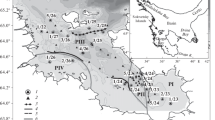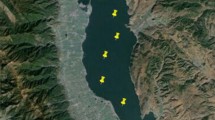Abstract
The stability of the water column permitted stable stratification of the shallow (maximum depth: 3.75 m) oxbow, Kecskészugi-Holt Körös in summer 2000. During the stratified period a deep chlorophyll maximum (DCM) was found at depths getting 60–180 μmol m−2 s−1 photosynthetically active radiation (PAR). The phytoplankton was dominated by Ceratium hirundinella and it is concluded that the development of the DCM largely resulted from the behavioural aggregation of this motile flagellate.
Similar content being viewed by others
References
Bienfang, P., J. Szyper & E. Laws, 1983. Sinking rate and pigment responses to light limitation of a marine diatom: implications to dynamics of chlorophyll maximum layers. Oceanol. Acta 6: 55–62.
Bowers, J. A., 1980. Effects of thermocline displacement upon surface chlorophyll maxima in Lake Michigan. J. Great Lakes Res. 6: 367–370.
Cullen, J. J., 1982. The deep chlorophyll maximum: comparing vertical profiles of chlorophyll-a. Can. J. Fish. Aquat. Sci. 39: 791–803.
Cullen, J. J. & R. W. Eppley, 1981. Chlorophyll maximum layers of the Southern California Bight and possible mechanism of their formation and maintenance. Oceanol. Acta 4: 23–32.
Fee, E. J., 1976. The vertical and seasonal distribution of chlorophyll in lakes of the experimental Lakes Area, Northwestern Ontario: implications for primary production estimates. Limnol. Oceanogr. 21: 767–783.
Fakuhara, H., A. Kawakami & T. Shimogaito, 2003. Characteristics of nutrient dynamics in Lake Seagate, Japan, a shallow sand dune lake. Hydrobiologia 506–509: 93–99.
Gálvez, J. A., F. X. Niell & J. Lucena, 1988. Description and mechanism of formation of a deep chlorophyll maximum due to Ceratium hirundinella (O. F. Müller) Bergh. Arch. Hydrobiol. 112: 143–155.
García-Ferrer, I., A. Camacho, X. Armengol, M. R. Miracle & E. Vicente, 2003. Seasonal and spatial heterogeneity in the water chemistry of two sewage-affected saline shallow lakes from central Spain. Hydrobiologia 506–509: 101–110.
Gligora, M., A. Plenkovi´c-Moraj & I. Ternjej, 2003. Seasonal distribution and morphological changes of Ceratium hirundinella in two mediterranean shallow lakes. Hydrobiologia 506–509: 213–220.
Grigorszky, I., S. Nagy, L. Krienitz, K. T. Kiss, M.M. Hamvas, A. Tóth, G. Borics, C. Máthé, B. Kiss, G. Borbély, G. Dévai & J. Padisák, 2000. Seasonal succession of phytoplankton in a small oligotrophic oxbow and some consideration to the PEG model. Verh. int. Ver. Limnol. 27: 152–156.
Heaney, S. I. & R.W. Eppley, 1980. Ligth, temperature and nitrogen as interacting factors affecting diel vertical migration of dino-flagellates in culture. In: Research of the Marine Food Chain, Institute of Marine resources, University of California, Report, 80–1: 165–180.
Heaney, S. I. & T. I. Furnass, 1980. Laboratory models of diel vertical migration in dinoflagellates Ceratium hirundinella. Freshwat. Biol. 10: 163–170.
Holligan, P.M., 1978., Patchiness in subsurface phytoplankton populations on the Northwest European continental shelf. In: Steele, J. H. (ed.), Spatial Patterns in Plankton Communities. Plenum Press, New York: 222–238.
Holopainen, A.-L., R. Niinoja & A. Rämö, 2003. Seasonal succession, vertical distribution and long term variation of phytoplankton communities in two shallow forest lakes in eastern Finland. Hydrobiologia 506–509: 237–245.
Kiefer, D. A., R. J. Olson & O. Holm-Hansen, 1976. Another look at the nitrite and chlorophyll maxima in the central North Pacific. Deep Sea Res. 23: 1199–1208.
Leland, H. V., 2003. The influence of water depth and flow regime on phytoplankton biomass and community structure in a shallow, lowland river. Hydrobiologia 506–509: 247–255.
Longhurst, A. R., 1976. Interactions between zooplankton and phytoplankton profiles in the eastern tropical Pacific Ocean. Deep Sea Res. 23: 729–754. Nagy, M. T., K. Márialigeti, P. Végvári & E. Csépes, in press. Stratification analysis of the Óhalász oxbow of the River Tisza (Kisköre Reservoir, Hungary). Hydrobiologia 506–509: 37–44.
Nõges & R. Laugaste, 2003. Water level as mediator between climate change and phytoplankton composition in a large, shallow, temperature lake. Hydrobiologia 506–509: 257–263.
Padisák J., 1985. Population dynamics of the dinoflagellate Ceratium hirundinella in the largest shallow lake of Central Europe, Lake Balaton, Hungary. Freshwat. Biol. 15: 43–52. Padisák, J., F. A. R Barbosa, R. Koschel & L. Krienitz, in press a. Deep layer cyanoprokaryota maxima are constitutional features of lakes: examples from temperate and tropical regions. Arch. Hydrobiol., Adv. Limnol. Padisák, J. G. Borics, G. Fehér,I. Grigorszky, I. Oldal, A. Schmidt & Z. Zámbóné-Doma, in press b. Dominant species and frequency of equilibrium phases in late summer phytoplankton assemblages in Hungarian small shallow lakes. Hydrobiologia.
Padisák, J. & C. S. Reynolds, 2003. Shallow lakes: the absolute, the relative, the functional and the pragmatic. Hydrobiologia 506– 509: 1–11.
Padisák, J., W. Scheffler, C. Sípos, P. Kasprzak, R. Koschel & L. Krienitz, in press c. Spatial and temporal pattern of development and decline of the spring diatom populations in Lake Stechlin in 1999. Arch. Hydrobiol., Adv. Limnol.
Pálfy, I., 1995. Tisza-völgyi holtágak [Oxbows of Tissza River]. Közlekedési és Hírközlési Minisztérium, Budapest: 197 pp. [in Hungarian].
Perry, J. H., 1950. Chemical Engineers Handbook, Third Edition. McGraw-Hill Book Company, Inc. New York.
Sas, H., 1989. Lake restoration by reduction of nutrient loading: expectations, experiences, extrapolations. Akademie Verlag, Richarz GmbH, St. Augustin.
Steele, J. H., 1964. A study of production in the Gulf of Mexico. J. Mar. Res. 22: 212–222.
Taylor, W. D. & R. G. Wetzel, 1988. Phytoplankton community dynamics in Lawrence Lake of southwestern Michigan. Arch. Hydrobiol., Suppl. 81: 491–632.
Veinrick, E. L., S. A. McGowan & A. W. Mantyla, 1973. Deep maxima of photosynthetic chlorophyll in the Pacific Ocean. Fish. Bull. 71: 41–52.
Villalobos, J. A., 1985. Incorporación de fósoforo en dos comunidades del embalse eutrófico de La Concepción (istán, Málaga). Tesis de Licenciatura. Universidad de Málaga: 1–219.
Author information
Authors and Affiliations
Rights and permissions
About this article
Cite this article
Grigorszky, I., Padisák, J., Borics, G. et al. Deep chlorophyll maximum by Ceratium hirundinella (O. F. Müller) Bergh in a shallow oxbow in Hungary. Hydrobiologia 506, 209–212 (2003). https://doi.org/10.1023/B:HYDR.0000008632.57769.19
Issue Date:
DOI: https://doi.org/10.1023/B:HYDR.0000008632.57769.19




